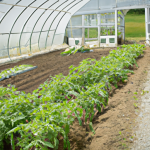Discover the benefits of urban farming and learn how to start your own urban farm. Increase sustainability, food security, and community engagement in urban areas.
Introduction
In recent years, the concept of urban farming has gained significant traction, offering a sustainable solution to the growing demand for locally sourced food in urban areas. With limited space and increasing environmental concerns, urban farms have emerged as a groundbreaking solution that not only promotes food security but also fosters community engagement and improves overall well-being. In this article, we will delve into the concept of urban farms, their benefits, and provide valuable insights on how to start your own urban farm.
What Are Urban Farms?
Definition and Benefits
Urban farms, also known as urban agriculture, are innovative methods of cultivating fresh produce within urban environments.
These farms can manifest in various forms, including rooftop gardens, community gardens, vertical farms, or indoor hydroponic setups. By utilizing unused or underutilized spaces, such as rooftops, vacant lots, or abandoned buildings, urban farms bring greenery and agricultural practices to the heart of the city.
Benefits of Urban Farms
![]()
1. Sustainability
Urban farms play a crucial role in mitigating the environmental impact of traditional agriculture. By reducing transportation distances, water usage, and the need for harmful pesticides, urban farms contribute to a more sustainable food system.
Additionally, they promote biodiversity and improve air quality, creating healthier and greener cities.
2. Food Security
With the global population steadily growing and diminishing farmland, urban farms help address food security challenges. By providing locally grown produce, urban farms reduce the dependence on imports and long-distance shipping. This ensures a consistent supply of fresh, nutritious food for urban communities.
3. Community Engagement
Urban farms serve as thriving community hubs, fostering increased social connections and neighborhood cohesion. By involving residents in farming activities, educational programs, and farmers’ markets, these farms create an inclusive environment that promotes healthier and more resilient communities.
How to Start Your Own Urban Farm
![]()
Planning and Preparation
Starting an urban farm requires careful planning and preparation to ensure success. Follow these essential steps to embark on your urban farming journey:
1. Assess the Available Space
Begin by evaluating the space you have available. This could include your rooftop, backyard, or even unused public land. Consider factors like sunlight exposure, accessibility, and the feasibility of expanding your farm in the future.
2. Determine Farming Methods
Select the farming method that aligns with your available space and resources.
Options range from traditional soil-based farming to hydroponics, aquaponics, or aeroponics. Research and choose the most suitable method for your urban farm.
3. Obtain Necessary Permits and Permissions
Before starting your urban farm, familiarize yourself with local regulations and obtain any necessary permits or permissions. These may include zoning regulations, water usage permits, or licenses for selling produce or operating a farmers’ market.
Conclusion
Urban farms represent an innovative and sustainable approach to meet the growing demand for locally sourced food in urban areas. By maximizing underutilized spaces, urban farmers are transforming city landscapes into productive and vibrant environments. Their numerous benefits, including increased sustainability, food security, and community engagement, make urban farms a vital component of our future. Armed with valuable insights on how to start your own urban farm, you can contribute to this movement while simultaneously enjoying the fresh produce and stronger community ties that come with it.



